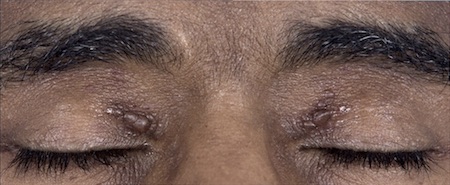History and exam
Key diagnostic factors
common
jugular venous distention
High right-sided filling pressure produces dramatic levels of jugular venous distention.[73]
lower extremity edema
Occurs due to hypoalbuminemia from nephrotic syndrome and may occur due to high right-sided filling pressures in the presence of restrictive cardiomyopathy. Present in approximately 50% of patients.[72]
uncommon
history of a chronic inflammatory condition, chronic infection, familial periodic fever syndrome
Secondary (AA) amyloidosis is typically associated with: chronic inflammatory conditions (e.g., inflammatory polyarthropathy, inflammatory bowel disease [specifically Crohn disease]); chronic infections (e.g., bronchiectasis, tuberculosis, subcutaneous injection of illicit drugs, decubitus ulcers, chronic urinary tract infections osteomyelitis); familial periodic fever syndromes (e.g., familial Mediterranean fever, tumor necrosis factor (TNF) receptor-associated periodic fever syndromes [TRAPS], cryopyrin-associated periodic syndromes [CAPS; such as Muckle-Wells syndrome], mevalonate kinase deficiency [formerly known as hyper-IgD syndrome]).[16][23][24][25][26]
history of monoclonal gammopathy of undetermined significance (MGUS)
History may reveal a prior diagnosis of MGUS.[57]
Patients with MGUS have a relative risk of progression to AL amyloidosis (the most common type of amyloidosis) of eight- to ninefold.[4][57][58]
It is important to note, however, that an incidental monoclonal gammopathy may be present in patients with other types of amyloidosis (e.g., hereditary amyloidosis, wild-type transthyretin [ATTRwt] amyloidosis), which can lead to a misdiagnosis of AL amyloidosis.[27][28][60]
periorbital purpura
Amyloid purpura occurs in approximately 15% of patients with AL amyloidosis.[48] It is typically periorbital, but can occur anywhere above the nipple line.[Figure caption and citation for the preceding image starts]: Bilateral periorbital ecchymosis (amyloid purpura) in a patient with AL amyloidosisWilliams MU, Murphy CE, Gore RS, et al. BMJ Case Rep 2018;11:e225923. doi:10.1136/bcr-2018- 225923 [Citation ends]. [Figure caption and citation for the preceding image starts]: Classic periorbital purpuraMorie A. Gertz, MD; courtesy of Mayo Clinic [Citation ends].
[Figure caption and citation for the preceding image starts]: Classic periorbital purpuraMorie A. Gertz, MD; courtesy of Mayo Clinic [Citation ends].
eyelid petechiae
Eyelid petechiae are common; only evident when eyes are closed. May be confused with immune thrombocytopenia (ITP) or coagulopathy, but is highly specific for amyloidosis.
macroglossia
Specific and diagnostic sign for AL amyloidosis.[48] Occurs in approximately 10% of patients, but is easily overlooked because the most common presentation is dental indentations on the underside of the tongue. [Figure caption and citation for the preceding image starts]: Macroglossia in a patient with AL amyloidosisWilliams MU, Murphy CE, Gore RS, et al. BMJ Case Rep 2018;11:e225923. doi:10.1136/bcr-2018- 225923 [Citation ends].
Other diagnostic factors
common
fatigue
Manifestation of systemic disease and is commonly present in patients with early amyloid cardiomyopathy and nephrotic syndrome. Present in approximately 60% of patients.[41]
weight loss
Extreme weight loss (e.g., >9 kg) is common (particularly in patients with cardiac and hepatic involvement) and is suggestive of amyloidosis if associated with edema or neuropathy.[48]
The history may have prompted a detailed search for occult malignancy.
dyspnea on exertion
Dyspnea on exertion is a common finding in patients with amyloid cardiomyopathy. Associated with edema when right-sided filling pressures are elevated. Present in approximately 40% of patients.[48]
uncommon
peripheral neuropathy
Nerve involvement can lead to peripheral neuropathy, and is most commonly associated with immunoglobulin light chain (AL) amyloidosis and hereditary transthyretin (ATTRv) amyloidosis. Mild peripheral neuropathy may occur in patients with wild-type transthyretin (ATTRwt) amyloidosis (up to 20%).[55]
Nerve involvement is not a typical feature of secondary (AA) amyloidosis, non-TTR hereditary amyloidosis, or LECT2 amyloidosis.[3]
Initial presentation is usually distal symmetric sensory loss (i.e., loss of temperature and pain perceptions, followed by proprioceptive loss).[50] Patients usually report dysesthesia and paresthesia of the feet and lower legs, which progress to the hands and arms over time.
Peripheral neuropathy is an important diagnostic clue for AL amyloidosis and ATTRv amyloidosis.[50]
autonomic neuropathy
Nerve involvement can lead to autonomic neuropathy, and is most commonly associated with AL amyloidosis and ATTRv amyloidosis.
Nerve involvement is not a typical feature of AA amyloidosis, non-TTR hereditary amyloidosis, or LECT2 amyloidosis.[3]
Patients with autonomic neuropathy may have erectile dysfunction, orthostatic hypotension, gastrointestinal dysfunction, or urinary dysfunction.[18][68] Sweating abnormalities and failure of heart rate to change when body position is changed are signs of autonomic dysfunction.
Autonomic neuropathy is an important diagnostic clue for AL amyloidosis and ATTRv amyloidosis.[50]
claudication
Consequence of amyloid involvement of the small vessels in the peripheral arteries. Results in jaw, calf, and limb claudication. Rarely, patients may have angina.
nausea or vomiting
If upper gastrointestinal tract is involved, nausea or vomiting may be present (pseudo-obstructive symptoms).
abdominal cramps
If upper gastrointestinal tract is involved, postprandial abdominal cramping may occur (pseudo-obstructive symptoms).
alternating bowel habit
Severe fecal incontinence alternating with 3-4 days of constipation may be present.
steatorrhea
Typical sign of intestinal involvement.
lightheaded
Lightheadedness can be a consequence of cardiac amyloidosis (low cardiac output with preserved ejection fraction on the echocardiogram) or nephrotic syndrome (hypoalbuminemia and intravascular volume contraction).
submandibular salivary gland enlargement
Specific for AL amyloidosis. May be misinterpreted as lymphadenopathy. Salivary gland involvement results in a sicca syndrome. These patients often are misdiagnosed as having Sjögren syndrome.
hepatomegaly
Palpable hepatomegaly >5 cm below the right costal margin, most commonly reported in AL amyloidosis (approximately 10% of patients).[16][48]
Palpable hepatomegaly is uncommon in AA amyloidosis, but histopathologic changes in the liver may be evident. Liver involvement is rare in patients with hereditary amyloidosis.
shoulder pad sign
A rare sign, specific for AL amyloidosis. Periarticular infiltration with amyloid produces pseudohypertrophy, resulting in enlargement of the musculature of the shoulder and hip girdles.
diffuse muscular weakness
Can occur due to extracellular amyloid infiltration in the muscle (muscle hypertrophy) or due to vascular occlusion leading to muscle ischemia and claudication (muscular atrophy).
orthostatic hypotension
Orthostatic hypotension with syncope can occur if autonomic neuropathy is present (e.g., in AL amyloidosis or ATTRv amyloidosis).
carpal tunnel syndrome
Carpal tunnel syndrome prevalence is greatest in patients with TTR cardiac amyloidosis (20.3% vs. 4.1% in the general population), but it is also a manifestation of AL amyloidosis.[69]
Tinel sign (tapping over the carpal nerve at the wrist produces tingling in the thumb, index, and middle finger) and Phalen maneuver (holding the dorsal surface of both hands together in forced flexion for around 1 minute produces tingling in the thumb, index, and middle finger) should be performed to test for carpal tunnel syndrome involvement in patients reporting paresthesia in the hands.
Risk factors
strong
monoclonal gammopathy of undetermined significance (MGUS)
inflammatory polyarthropathy
Most common underlying cause of secondary (AA) amyloidosis.
Includes patients with rheumatoid arthritis, juvenile arthritis, psoriatic arthritis, and ankylosing spondylitis.[16]
chronic infections
Risk for secondary (AA) amyloidosis.
Causes include bronchiectasis, tuberculosis, subcutaneous injection of illicit drugs, decubitus ulcers, chronic urinary tract infections, and osteomyelitis.[16]
inflammatory bowel disease
Risk for secondary (AA) amyloidosis.
In particular Crohn disease.[16]
familial periodic fever syndromes
Familial Mediterranean fever, tumor necrosis factor (TNF) receptor-associated periodic fever syndromes (TRAPS), cryopyrin-associated periodic syndromes (CAPS; e.g., Muckle-Wells syndrome), and mevalonate kinase deficiency (formerly known as hyper-IgD syndrome) have been implicated in secondary (AA) amyloidosis.[23][24][25][26]
Use of this content is subject to our disclaimer